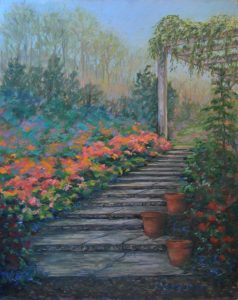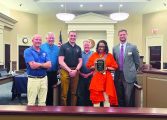By Page H. Gifford
Correspondent
Lorraine Momper is a long-time member of the Fluvanna Art Association but is also one of few that that uses pastels. She sums up why it is important to belong to special interest groups like the FAA.
“I am a firm believer in looking for groups that focus on your interests, the people who speak your language, whether that be car engines or art or whatever. Groups mean that you benefit from a composite of acquired skills and knowledge, trial and error, that you won’t get in any one book or You Tube video.” Many members come together to share ideas and learn new techniques regardless of skill level. Some feel they cannot create unless they are motivated by a group of like-minded individuals. But for the majority of members, like Momper, it is to learn and share. One is never so good they cannot learn something new.
Her int roduction to art was like many who have a similar experience growing up in schools that had little or no art classes and no formal degree in art. Growing up on a farm in Nebraska she said her early passion for art was an “avid interest and no formal training.” Her parents recognized her love of art and gave her an oil painting set when she was 12. She used her allowance to buy brushes, more paint, and instruction books. Her father built her an easel which she still has. Her mother, who was self-taught, painted some floral murals. She taught Lorraine some techniques to help her build her skills.
roduction to art was like many who have a similar experience growing up in schools that had little or no art classes and no formal degree in art. Growing up on a farm in Nebraska she said her early passion for art was an “avid interest and no formal training.” Her parents recognized her love of art and gave her an oil painting set when she was 12. She used her allowance to buy brushes, more paint, and instruction books. Her father built her an easel which she still has. Her mother, who was self-taught, painted some floral murals. She taught Lorraine some techniques to help her build her skills.
There were 27 in her graduating class at a small country school in a farming community where art was not viewed as a necessity. She worked independently with the help of the shop teacher who had a minor in art, who gave her assignments to work on at home.
In her 20s, after college, she attempted watercolor painting, and like many of her fellow artists succumbed to the frustration of mastering watercolor painting.
After moving to Virginia, she discovered her love of soft pastels and eventually joined the Piedmont Pastelists, a local group of soft pastel artists started in Charlottesville by Richard Carpenter, an artist who later became her mentor. Other FAA artists, including Mike McGurk and Liz Ellis, also studied under Carpenter.
 “I have concentrated on working with soft pastels because I love color. The pigments in soft pastels are the most concentrated of any art medium,” she said. “Many people think of pastels as chalk, but they are thinking of the pastel sticks that they used in grade school, which are far removed from true art pastels.” Soft pastels sticks are pure pigment suspended in a binder to give them their shape, are classified as soft, medium, or hard, and come in hundreds of colors, and do not require a solvent to use, such as water or thinner. But they do work best on certain types of surfaces like sandpaper which holds the pigment.
“I have concentrated on working with soft pastels because I love color. The pigments in soft pastels are the most concentrated of any art medium,” she said. “Many people think of pastels as chalk, but they are thinking of the pastel sticks that they used in grade school, which are far removed from true art pastels.” Soft pastels sticks are pure pigment suspended in a binder to give them their shape, are classified as soft, medium, or hard, and come in hundreds of colors, and do not require a solvent to use, such as water or thinner. But they do work best on certain types of surfaces like sandpaper which holds the pigment.
She still works with oil paints only in a Plein-Air setting but also paints with acrylic, gouache, and occasionally watercolor. She has also taken class in mono-printing at the Virginia Museum of Fine Arts and dabbled in ink, watercolor, and acrylic monoprints and linoleum block prints. But her ultimate favorite is pastels.
She paints mostly landscapes, but also still life, florals, animals/birds, and people, all in traditional or contemporary paintings.
“I look for the narrative in a painting, something unique that I am trying to convey. I believe that art is a silent conversation between the artist and the viewer. My favorite subjects are animals and people because of the challenge to capture a personality in a face.” Her style is quiet, reflected in the haunting solitude of her subjects. “I am inspired by color and light, a flash of light on an object or a face, expressive eyes, or a serene landscape capturing something fleeting.”
The human face and figure are mostly avoided by many FAA artists in their work. Momper explained why this occurs.
“My most challenging subjects are people because I get caught up on capturing ‘likeness’ and personality, but that can be very time-consuming and elusive at times. If the placement of the features or the lines of a mouth are off by a tiny amount, or the skin tones are wrong, it won’t read correctly. In an animal, it can be easier to jump this hurdle because of fur.”
Every artist has an approach to working on and completing a piece.
“I love the spontaneous first half of a painting, watching a painting take form quickly because you don’t necessarily know which way it will go. As in life, every moment, every stroke, is a decision, and you are making spontaneous decisions that no one else could duplicate. If one decision is a bad, you can’t focus on that as a failure because a roadblock is just a detour to where you should have gone, Your brain catalogs what doesn’t work. Building skills is the process of failing and learning.” Many professional artists have learned that if something doesn’t work, you set it aside and later a new perspective emerges.
“If I am not happy with a painting, I set it aside, sometimes for several years, and almost always I know what I need to do when I come back to it. Your brain fills in the gaps over time, and later you know what you should have done or not done, even in a painting that you have already framed, because you have acquired skills and experience. I do keep my failures because I learn from them.”
Other than FAA, Momper also belongs to and exhibits with other local and regional pastel groups, including The Piedmont Pastelists, the MidAtlantic Pastel Society, and the Maryland Pastel Society. And last year she was accepted (juried) into the Pastel Society of America.




